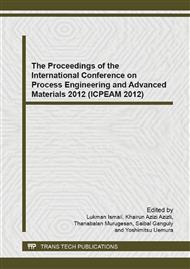[1]
Processing Natural Gas (n. d). Citing Websites. NaturalGas. org. Retrieved January 3, 2012, from http: /www. naturalgas. org/naturalgas/processing_ng. asp.
Google Scholar
[2]
A.I. Kohl, R. B Nielsen. Gas Purification. 5th ed., Gulf Publishing Company, Houston, TX, USA, (1997).
Google Scholar
[3]
M. Furhacker, A. Pressl, R. Allabashi, Aerobic biodegradability of methyldiethanolamine (MDEA) used in natural gas sweetening plants in batch tests and continuous flow experiments, Chemosphere 52 (2003) 1743-1748.
DOI: 10.1016/s0045-6535(03)00371-0
Google Scholar
[4]
A. A Omar, R.M. Ramli, P.F. Khamaruddin, Fenton oxidation of natural gas plant wastewater, Canadian Journal on Chemical Engineering & Technology 1(1) (2010) 1-6.
Google Scholar
[5]
M. Vinita, R. Praveena Juliya Dorathi, K. Palanivelu, Degradation of 2, 4, 6-trichlorophenol by photo Fenton's like method using nano heterogeneous catalytic ferric ion, Solar Energy 84(9) (2010) 1613-1618.
DOI: 10.1016/j.solener.2010.06.008
Google Scholar
[6]
A. Neren Okte, S. Akalin, Iron (Fe3+) loaded TiO2 nanocatalysts: characterization and photoreactivity, Reac Kinet Mech Cat. 100 (2010) 55-70.
DOI: 10.1007/s11144-010-0168-0
Google Scholar
[7]
X. Shen, J. Zhang, B. Tian, Microemulsion-mediated solvothermal synthesis and photocatalytic properties of crystalline titania with controllable phases of anatase and rutile, Journal of Hazardous Materials 192 (2011) 651-657.
DOI: 10.1016/j.jhazmat.2011.05.066
Google Scholar
[8]
C. Adan, J. Carbajo, A. Bahamonde, A. Martı´nez-Arias, 2009. Phenol photodegradation with oxygen and hydrogen peroxide over TiO2 and Fe-doped TiO2, Catalysis Today 143(2009) 247-252.
DOI: 10.1016/j.cattod.2008.10.003
Google Scholar
[9]
B. Tryba, A.W. Morawski, M. Inagaki, M. Toyoda, Mechanism of phenol decomposition on Fe-C-TiO2 and Fe-TiO2 photocatalysts via photo-Fenton process, Journal of Photochemistry and Photobiology A Chemistry 179 (2006) 224-228.
DOI: 10.1016/j.jphotochem.2005.08.019
Google Scholar
[10]
M. Asiltürk, F. Sayılkan, E. Arpac, Effect of Fe3+ ion doping to TiO2 on the photocatalytic degradation of Malachite Green dye under UV and vis-irradiation, Journal of Photochemistry and Photobiology A Chemistry 203 (2009) 64-71.
DOI: 10.1016/j.jphotochem.2008.12.021
Google Scholar
[11]
N. Banić, B. Abramović, J. Krstic, D. Sojic, L. Davor, Z. Cherkezova-Zheleva, V. Guzsvány, Photodegradation of thiacloprid using Fe/TiO2 as a heterogeneous photo-Fenton catalyst, Applied Catalysis B: Environmental 107(3-4) (2011) 363-371.
DOI: 10.1016/j.apcatb.2011.07.037
Google Scholar
[12]
N.A. Jamalluddin, A.Z. Abdullah, Reactive dye degradation by combined Fe(III)/TiO2 catalyst and ultrasonic irradiation: Effect of Fe(III) loading and calcination temperature, Ultrasonics Sonochemistry, 18 (2011) 669-678.
DOI: 10.1016/j.ultsonch.2010.09.004
Google Scholar
[13]
N.D. Abazovic´, L. Mirenghi, I.A. Jankovic´, N. Bibic´, D.V. Sojic´,B.F. Abramovic´, M.I. Comor, Synthesis and characterization of rutile TiO2 nanopowders doped with iron ions, Nanoscale Res. Lett. 4 (2009) 518-525.
Google Scholar
[14]
A.L. Linsebigler, G. Lu, J.T. Yates Jr., Photocatalysis on TiO2 surfaces principles, mechanisms and selected results, Chem. Revision 95 (1995) 735-758.
DOI: 10.1021/cr00035a013
Google Scholar
[15]
M. Klare, J. Scheen, K. Vogelsang, H. Jacobs, J.A.C. Broekaert, Degradation of short-chain alkyl- and alkanolamines by TiO2- and Pt/TiO2-assisted photocatalysis, Chemosphere 41 (2000) 353-362.
DOI: 10.1016/s0045-6535(99)00447-6
Google Scholar
[16]
I. Eide-Haugmo, O.G. Brakstad, K.A. Hoff, K.R. Sørheim, E.F. da Silva, H.F. Svendsen, Environmental impact of amines, Energy Procedia 1(1) (2009) 1297-1304.
DOI: 10.1016/j.egypro.2009.01.170
Google Scholar
[17]
C.S. Lu, C.C. Chen, F.D. Mai, H.K. Li, Identification of the degradation pathways of alkanolamines with TiO2 photocatalysis, Journal of Hazardous Materials 165(1-3) (2009) 306-316.
DOI: 10.1016/j.jhazmat.2008.09.127
Google Scholar
[18]
Department of Environment, Malaysia, 1974. Environmental Quality (Sewage and Industrial Effluents) Regulation 1979 [Act 127]. In Environmental Quality Act (EQA).
Google Scholar
[19]
J.S. Noh, J.A. Schwarz, Estimation of the point of zero charge of simple oxides by mass titration, Journal of Colloid and Interface Science 130(1) (1989) 157-164.
DOI: 10.1016/0021-9797(89)90086-6
Google Scholar
[20]
J. Carbajo, C. Adán, A. Rey, A. Martínez-Arias, A. Bahamonde, Optimization of H2O2 use during the photocatalytic degradation of ethidium bromide with TiO2 and iron-doped TiO2 catalysts, Applied Catalysis B: Environmental 102(1-2) (2011) 85-93.
DOI: 10.1016/j.apcatb.2010.11.028
Google Scholar
[21]
A. Di Paola, S. Ikeda, G. Marcì, B. Ohtani, L. Palmisano, Transition metal doped TiO2: physical properties and photocatalytic behaviour, International Journal of Photoenergy 3 (2001) 171-176.
DOI: 10.1155/s1110662x01000216
Google Scholar
[22]
V. Kavitha, K. Palanivelu, The role of ferrous ion in Fenton and photo-Fenton processes for the degradation of phenol, Chemosphere 55 (2005) 1235-1243.
DOI: 10.1016/j.chemosphere.2003.12.022
Google Scholar
[23]
M. Anpo, M. Takeuchi, The design and development of highly reactive titanium oxide photocatalysts operating under visible light irradiation, Journal of Catalysis 216(1–2) (2003) 505-516.
DOI: 10.1016/s0021-9517(02)00104-5
Google Scholar
[24]
M.S. Nahar, K. Hasegawa, S. Kagaya, S. Kuroda, Comparative assessment of the efficiency of Fe-doped TiO2 prepared by two doping methods and photocatalytic degradation of phenol in domestic water suspensions, Science and Technology of Advanced Materials 8 (2007).
DOI: 10.1016/j.stam.2007.04.005
Google Scholar
[25]
W. Choi, A. Termin, M.R. Hoffmann, The role of metal ion dopants in quantum-sized TiO2: Correlation between photoreactivity and charge carrier recombination dynamics, The Journal of Physical Chemistry 98(51) (1994) 13669-13679.
DOI: 10.1021/j100102a038
Google Scholar
[26]
M. Janus, A. Morawski, New method of improving photocatalytic activity of commercial Degussa P25 for azo dyes decomposition, Applied Catalysis B: Environmental 75 (2007) 118-123.
DOI: 10.1016/j.apcatb.2007.04.003
Google Scholar
[27]
H. Slimen, A. Houas, J.P. Nogier, Elaboration of stable anatase TiO2 through activated carbon addition with high photocatalytic activity under visible light, Journal of Photochemistry and Photobiology A: Chemistry 221 (2011) 13-21.
DOI: 10.1016/j.jphotochem.2011.04.013
Google Scholar
[28]
P. Sathishkumar, S. Anandan, P. Maruthamuthu, T. Swaminathan, M. Zhou, M., Ashokkumar, Synthesis of Fe3+ doped TiO2 photocatalysts for the visible assisted degradation of an azo dye, Colloids and Surfaces A: Physicochemical and Engineering Aspects, 375 (2011).
DOI: 10.1016/j.colsurfa.2010.12.022
Google Scholar
[29]
X. Shen, J. Zhang, B. Tian, Microemulsion-mediated solvothermal synthesis and photocatalytic properties of crystalline titania with controllable phases of anatase and rutile, Journal of Hazardous Materials 192 (2011) 651-657.
DOI: 10.1016/j.jhazmat.2011.05.066
Google Scholar


